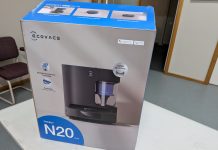The Pixel 3 XL is the new hotness in the smartphone world, and the folks over at iFixit have gotten their hands on one and done what they do best, tear it down and see what makes it tick.
The phone has a number of positives when it comes to repairability, unfortunately these are outweighed by some not so good features, which means the phone drops down to a 4/10 rating for repairability from a 6/10 the previous year for the Pixel 2 XL.
The good includes the use of standard ‘T3 Torx fasteners’ and a repair-friendly stretch-release adhesive which secures the battery.
The ‘Ok’ includes the use of o-rings and adhesives for waterproofing which they say will complicate repairs, though it’s these components that means that difficult liquid damage repairs will be less likely.
The real guts of the teardown unfortunately reveal that to get to any repairs, you’ll need to unglue and then re-glue the rear glass panel – a process that’s onerous according to iFixit. This means that display repairs will be more difficult than previous Pixel phones with the entire phone needing to be disassembled before replacing the screen.
Lastly, they’ve noted that as with most phones these days, the use of glass front and back means there’s an ‘increased vulnerability to drop damage’.
A big discovery in the teardown is that Google has moved from LG to Samsung as their flexible OLED supplier this year. The switch to Samsung – a notable leader in mobile phone displays – could possibly explain the lack of complaints about ‘blue shift’ on the panels this year.
The teardown also shows off the new ‘Titan’ security chip, which is Google’s new hardware layer protecting your phone with disk encryption, app data, login credentials and the integrity of the Operating System. Seen here outlined in red, the chip is sort of a hardware layer that protects the users application data, login credentials and the OS and also implements disk encryption.
There’s no confirmation, but the iFixit team also believes the rear camera uses a slighly updated Sony IMX363 sensor (the Pixel 2 used a Sony IMX362) alongside the Intel built Visual Core processor.
![]()
If you want to look at all the teardown porn – they used a Not Pink model for the teardown – you can head over to the iFixit page to check it all out.
Update:
If you like teardown porn and the Pixel 3 XL wasn’t enough, the Pixel 3 has received the same treatment as its larger brother but for the most part it’s the same except for one key parts difference…the screen. According to the iFixit team, the Pixel 3 uses an LG panel:
Teardown Update: After finding a Samsung-made OLED display in the larger Pixel 3 XL, we dissected the display in our vanilla Pixel 3. Surprise—it’s from LG Display!
This is a full reversal from the situation last year, when the Pixel 2 got a Samsung panel and its bigger sibling had a display from LG.
You can see the smallish update (it’s small because it’s essentially identical to the Pixel 3 XL in build and assembly) you can head over here.




Good stuff , it seems google did not cheap out on the display this year , and as far as the repair rating goes , it should not be a problem if you look after your gear with a case .